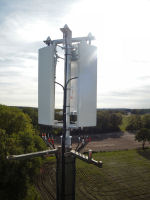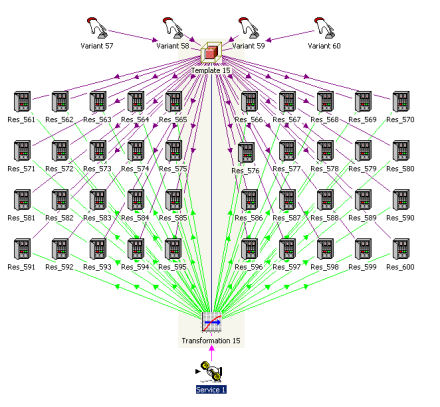Independent consultants DOK Systeme have been using STEM as a generic platform
for modelling the cost and revenue drivers associated with the use of WiMAX to target
digitally disadvantaged rural areas of Germany (as part of a consortium involving
EWE TEL and the universities of Hanover and Brunswick). This article explores some
of the market and technical issues which the model addresses, and identifies a number
of potential risks to the business model which has been established so far.
Pilot project with WiMAX infrastructure
German carriers still concentrate their roll-out plans for broadband access on areas
of high population density such as larger cities and urban areas. For example, the
incumbent Deutsche Telekom focuses on a VDSL roll-out where up to 100Mbit/s are
available over short distances. In contrast, rural areas often suffer, and typically
only ISDN data rates of up to 128kbit/s are available. In addition, wireless solutions
like UMTS or HSPA are often not available.
The German government has decided to support carriers in an effort to provide a
bandwidth of at least 2Mbit/s in these rural areas in the next few years. In the
longer term, the aim is to ensure a target speed of 50MBit/s for everyone. New public
funding programs have been designed to try to improve the situation in towns with
poor coverage. However, a disadvantage of these funding programs from a strategic
point of view is that, depending on the funding rules in place, each county can
decide by itself how to use the money: to subsidise carriers, or to invest the money
itself in passive infrastructure as a basis for open access networks.
 Together
with the universities of Hanover and Brunswick, DOK Systeme wrote a feasibility
study to find out whether WiMAX can be used as an economically viable technology
for broadband access. As a result, the federal state of Lower Saxony decided to
start a pilot project in which two counties will get WiMAX infrastructure. Part
of the project is a further examination of the technology issues. The universities
will do research on the impact of different carrier frequencies, coverage and propagation
models, and the performance of the links. EWE TEL, a regional carrier and service
provider, will try to evaluate whether the technology is an appropriate alternative
to new cabling in the ground. DOK Systeme, as part of a consortium with EWE TEL
and the two universities, was chosen to provide a more detailed business case for
this project, which examines various factors, including:
Together
with the universities of Hanover and Brunswick, DOK Systeme wrote a feasibility
study to find out whether WiMAX can be used as an economically viable technology
for broadband access. As a result, the federal state of Lower Saxony decided to
start a pilot project in which two counties will get WiMAX infrastructure. Part
of the project is a further examination of the technology issues. The universities
will do research on the impact of different carrier frequencies, coverage and propagation
models, and the performance of the links. EWE TEL, a regional carrier and service
provider, will try to evaluate whether the technology is an appropriate alternative
to new cabling in the ground. DOK Systeme, as part of a consortium with EWE TEL
and the two universities, was chosen to provide a more detailed business case for
this project, which examines various factors, including:
- the effects of market penetration
- risks related to alternative technologies (e.g., LTE, or new xDSL versions providing
greater reach) and standard ‘marked offers’ priced to ‘kill’ the new competitor
- cost structures relating to line-of-sight issues
- impact of the possible need for indoor or outdoor units.
Although the work on the infrastructure has now been finalised, the business-case
analysis and results are still in progress. This article focuses on the modelling
techniques used, with an integrated STEM–Excel business case.
Standardised STEM modelling approach
Due to the fact that broadband access projects are typically very small, one focus
of the project has been to develop a very standardised modelling approach. To simplify
the model, a pure cost and revenue driven methodology has been used.
STEM has the ability to import input data from an Excel file, and to export the
model results back for an optimised presentation to customers. Based on our experience
of a lot of STEM-based business cases developed in previous projects, we were able
to build an optimised Excel file for input and output of data to and from STEM.
In a first step we build a model of 600 standardised resources. All resource-dependent
variables are linked to the resources using the Defaults formula mechanism. We then
replicate the resources four times by using four variants, and link capital costs,
maintenance costs and planned units to these variants. We use this method to easily
generate scenarios or sub-parts of the whole project without needing to change the
Excel data file.
In Excel we build up separate sheets for capital costs, maintenance costs and planned
units for each scenario, which contain all the input data in large arrays. The cells
within the arrays contain similar formulae which will be changed only in case of
need.
The whole STEM model uses neutral names like Resource_001 and so on, so it can be
re-used for the next project without renaming them. Also, the Excel range names
for linking between Excel and STEM use the same mechanism. One disadvantage of this
approach is that STEM is being relegated to being a pure computation machine, and
views with linked icons representing the network elements are no longer very meaningful.
All the Excel sheets are linked to a single central sheet where the resource numbers
are combined with their actual names. This approach allows us to build up a new
model within a very short time. It also makes the model itself more stable, as the
number of errors in the Excel formulae will decrease over time.

Part of the generic STEM model [Source: DOK Systeme]
The results generated by STEM are imported into Excel in a standardised way. For
each resource, the installed units, capital costs, maintenance costs and depreciation
are imported. Based on this information and , profit and loss sheets and cash flow
statements for all four scenarios are implemented. Individual cost elements are
grouped under various sub-headings (such as personnel or material costs) through
the use of a special key-index mechanism.
The business case for the pilot project was designed to handle different access
technologies, so as to compare the installed WiMAX project with other technological
approaches that could have been used. Thus we are able to calculate cases for ADSL
and SDSL, using dark fibre or leased lines, WiMAX, UMTS and cable TV.
All costs that are independent of a particular deployment area, e.g. the costs of
central equipment such as for network management, are stored in a central sheet.
In contrast, all other element costs, and the number of planned units of each resource,
have to be filled in for each region separately. Due to this standardisation, it
is possible to fill in values in the model very quickly. The chance of making errors
is very low as no formulae have to be changed.
Elements of the business case
After building the STEM model it has to be filled with data. For this project we
had to analyse a WiMAX infrastructure containing the customer equipment, base station
with antenna, the access network (in this case point-to-point radio links), PoP
and central equipment like the network operations centre and the wireless access
controller in the service centre.
Together with the universities, the potential customer base within the chosen locations
was determined. Also, the existence of other broadband access technologies was investigated.
Based on the results of this analysis the amount of potential customers was calculated.
In the next step we had to find out exactly where the customers are located in the
area. So we generated detailed maps identifying the settled areas and the uninhabited
rural areas. We also took into account the business locations that have to be served
by the wireless networks. As a result, we identified potential locations for the
base stations, and were able to calculate the height and power of the antennas needed
to serve the customer locations. We focused on existing towers, wind turbines, and
so on.
After determining the base station locations and the areas which will be served
by each of them, we had to calculate the bandwidth which has to be handled by each
of those locations. The results of this calculation were needed to design the access
network and to calculate the PoP traffic.
Finally, the costs for the central equipment and the costs for the central and field
service maintenance teams were put into our model.
Core risks and impacts
As a result of the calculation we demonstrated that WiMAX can be used as a radio
access technology in rural areas. But there are several risks which may affect the
success of such an investment. One of the most critical threats is the penetration
rate. Based on similar projects, we established that the maximum penetration rate
that can be expected is 40% of customers. Also, a period of about 3.5 years is needed
to obtain a positive cash flow, even assuming that the WiMAX area is a part of a
bigger network and only direct costs have to be covered. Another very important
factor is the monthly fee the customers have to pay for the service. Compared to
the usual price for DSL or UMTS of about EUR20–30 per month, a fee of at least EUR70
per month is needed in our projections.
This all assumes that there is no other technology available in the area, and that
WiMAX is the only possibility available to get broadband access. If any other technology
becomes available, then the whole business case could collapse. A special risk is
the new frequency allocation rules for mobile network operators for future use of
UMTS or LTE. New rules and regulations published by the German regulator enforce
a prioritised coverage of the areas not covered by DSL (corresponding to 75% of
the population of this area) before other areas are allowed to be covered.
Dr. Jan Steuer, Marco Born and Simon F. Ruesche
 DOK Systeme GmbH
is a consulting company from Hanover, Germany, with about 30 employees, specialising
in ICT business and technology consulting. Since 2005 DOK Systeme has designed telecoms-related
business cases for different customers, which represent in sum a business of more
than EUR12 billion.
DOK Systeme GmbH
is a consulting company from Hanover, Germany, with about 30 employees, specialising
in ICT business and technology consulting. Since 2005 DOK Systeme has designed telecoms-related
business cases for different customers, which represent in sum a business of more
than EUR12 billion.